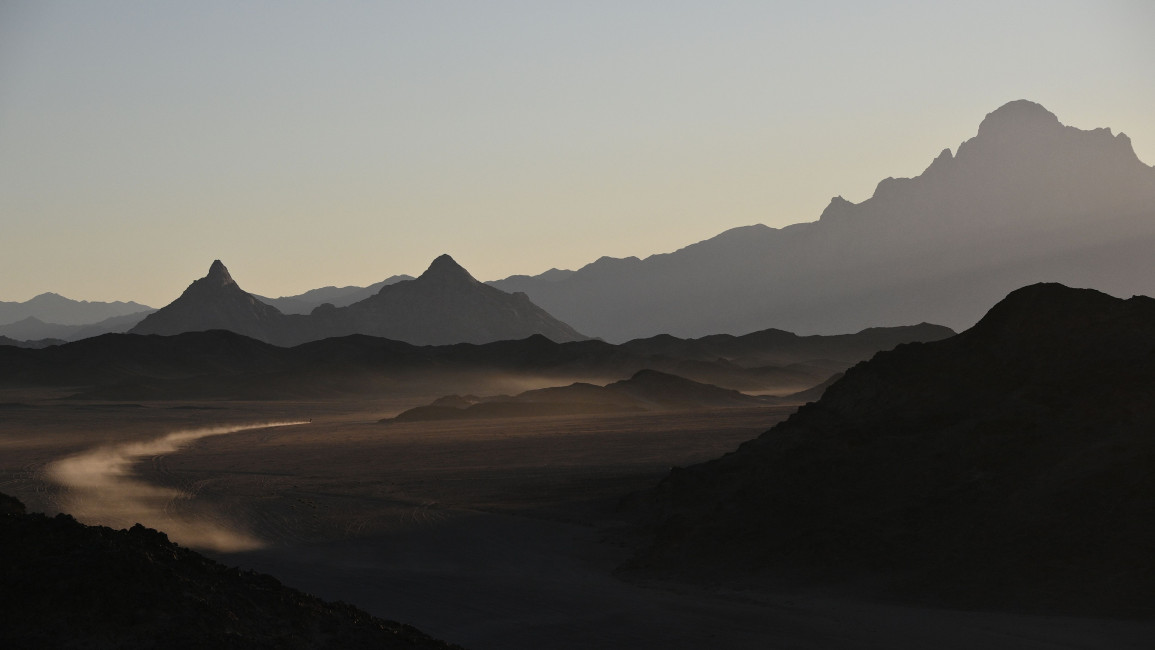
Is Saudi Arabia's 'The Line' NEOM project too ambitious?

Mohammed bin Salman (MBS), the crown prince of Saudi Arabia, recently unveiled plans for 'The Line', a linear city part of the futuristic NEOM project.
The Line is a proposed one-building city that will stretch for 170km and consists of tall mirrored skyscrapers. Its residents will use a high-speed train that travels between the two ends of the city in 20 minutes, and within five minutes they will have access to all city facilities and services.
The Line will be located near the Red Sea, spanning 34 square kilometres and with a capacity to host 9 million people. Despite its vast length, the proposed width of the linear city is just 200 metres, with the height of its skyscrapers reaching 500 metres - taller than the Empire State Building.
This city will be free of streets, automobiles, and greenhouse gas emissions and will rely 100% on renewable resources.
"While the initial plan was to complete NEOM by 2030 with an allotted $500 billion, some reports claim that the city may not be completed until 2050, which will likely increase costs significantly"
Linear progression
The Line is part of the NEOM project, an integral part of Saudi Arabia's Vision 2030 in which the latest urban construction technologies will be used to create a hydrocarbon-free economic zone. The aim is that Riyadh will be able to attract foreign investment and international corporations, increasing Saudi Arabia’s non-oil-generated wealth in a way that will compete with its regional rival the United Arab Emirates [UAE].
Initially launched in 2017, the NEOM project has been steadily progressing, despite criticisms about its ability to attract investment and concerns that there is limited time for completion.
“Now with eight years left until 2030, completing the Vision is the forefront priority of the Kingdom, so apprehensions regarding a possible slow down are baseless,” Arhama Siddiqa, a research fellow at the Institute of Strategic Studies Islamabad (ISSI), said in an interview with The New Arab.
Even the Covid-19 pandemic did not drastically slow the city’s construction. “In the aftermath of the pandemic, economic rehabilitation is at the forefront of all countries’ political agendas. This is why Saudi Arabia will have no issues in filling any labour gaps with regards to construction and investments in the project itself,” Siddiqa explained.
However, like other mega projects, NEOM is not without its challenges, some of which Riyadh has addressed and others which remain an obstacle.
Economic challenges
Financial challenges are the biggest obstacle for mega projects like NEOM and The Line. Research shows that Saudi Arabia has not been able to achieve much success in attracting financial resources and investment from foreign governments and companies.
While the initial plan was to complete NEOM by 2030 with an allotted $500 billion, some reports claim that the city may not be completed until 2050, which will likely increase costs significantly. For this reason, it is predicted that the entire project, including The Line, will cost the Kingdom $1 trillion.
The project is financed by the Public Investment Fund (PIF), the kingdom's sovereign wealth private investment fund. However, except for discussions with some foreign companies, including Russian ones, to build some of the infrastructure, Riyadh has not had success in other financial partnerships for NEOM.
|
|
“The only major foreign investment announced to date is the green hydrogen plant, and even the PIF-owned Lucid Group has decided to instead locate its electric vehicles factory in King Abdullah Economic City, which has a developed infrastructure and is located close to major population centres,” Justin Alexander, the director of Khalij Economics, told The New Arab.
The financial viability of PIF is highly dependent on the Kingdom’s oil exports, a market that has proven volatile in recent years. In 2020, Riyadh faced a significant fiscal deficit of more than $79 billion.
In a country where around 60% of its financial resources came from oil and just 9% from non-oil exports in 2021, the financing of the NEOM project is likely to face financial ups and downs.
The financial constraints of the market and a desire to be less dependent on oil resulted in a 5% value-added tax being introduced in 2018, which was then tripled to 15% in 2020. Due to tax pressure and inflation, some Saudis - who will ultimately bear the financial burden of this project - have expressed dissatisfaction with the lavish spending on high-profile projects.
“The finances coming from the PIF may also be affected by the oil-price volatility. Finally, Covid-19’s adverse impact on the project's finances and schedule needs to be offset effectively, as this risk was not incorporated during the planning of this project,” Asif Shuja, a senior research fellow at the Middle East Institute at the National University of Singapore, told The New Arab.
"Adhering to advanced technologies in urban design that will attract the attention of future residents of this city and investors is vital. Otherwise, NEOM would join a long list of unfinished cities across the Gulf"
Technological challenges
Because the NEOM project is an attempt to move the world from the era of the smart city to the age of the cognitive city, it requires overcoming the “challenges of technology" that Saudi Arabia cannot overcome alone.
In fact, The Line is not an entirely original architectural idea; in 1956 American architects Miles Graves and Peter Enzyman came up with a similar plan to create The Linear City between Boston and Washington, and architect Rem Koolhaas’s floating pool plan in the book Delirious New York from the 1970s has similar elements. However, turning these ideas into reality would be a significant win for the Kingdom.
“The important thing is to ensure the first-mover’s advantage, as some of the new technologies that would be specifically built for this futuristic city would soon be replicated by the competitor,” Shuja explained.
Adhering to advanced technologies in urban design that will attract the attention of future residents of this city and investors is vital. Otherwise, NEOM would join a long list of unfinished cities across the Gulf.
King Abdullah Economic City, a metropolis and port with an investment of $10 billion, houses fewer than 10,000 people after ten years, despite a projected population of two million. There is also the now abandoned Waterfront project in Dubai, the Blue City in Oman and, possibly the most infamous, Dubai's The World, which is now sinking back into the sea. Does NEOM offer anything that would shield it from the same fate?
Practically, the biggest technical problem that Saudi Arabia will face in NEOM is the reliance on foreign skilled workers, an issue that is unlikely to be resolved in the short term.
“Although the vision for NEOM is heavily geared around expatriate labour, if it is to contribute to the Kingdom's goals of creating quality private sector employment for its citizens then it will need to persuade Saudis to move far away from their families, which could be difficult to achieve,” Alexander said.
|
|
Social challenges
The final set of challenges that Riyadh will have to contend with are social. NEOM is located in the northwestern Tabuk province. In April 2020, the Saudi government planned to take over the land of the Howeitat tribe, which has been farming in this province for several generations.
Abdul-Rahim al-Howeiti, one of the members of this tribe, refused to hand over his ancestral land to the government and uploaded a video on YouTube predicting the possibility that he would be killed. Shortly after, he was killed by the police during a two-way shootout. His death sparked a wave of criticism from human rights defenders.
In addition, religious communities across the country have expressed dissatisfaction with MBS’s secularisation of Saudi society and the efforts to ‘modernise’ the country with projects such as NEOM and Vision 2030.
"Due to tax pressure and inflation, some Saudis - who will ultimately bear the financial burden of this project - have expressed dissatisfaction with the lavish spending on high-profile projects"
“Aside from technicalities, the real challenge to NEOM is how the Kingdom could use it as a symbol for a cultural purpose, particularly secularism, which would have to be tolerated by the entrenched clerical authority. Thus, the issue of ideational incompatibility of NEOM will not surface until the project is ready for service,” Omar Munassar, an assistant professor of International Relations at Bursa Uludağ University in Turkey, told The New Arab.
The Line and NEOM could prove a success for the Kingdom, attracting global investors and capturing the attention of the international community with MBS’s ambitious developments.
However, to do so, it will have to overcome both internal and external challenges around financial and technical feasibility, and define its role in a changing Saudi Arabia.
Dr Mohammad Salami holds a PhD in International Relations. He is a specialist in Middle Eastern policy, particularly in Syria, Iran, Yemen, and the Persian Gulf region. His areas of expertise include politics and governance, security, and counterterrorism.
Follow him on Twitter: @moh_salami



![President Pezeshkian has denounced Israel's attacks on Lebanon [Getty]](/sites/default/files/styles/image_684x385/public/2173482924.jpeg?h=a5f2f23a&itok=q3evVtko)



 Follow the Middle East's top stories in English at The New Arab on Google News
Follow the Middle East's top stories in English at The New Arab on Google News


